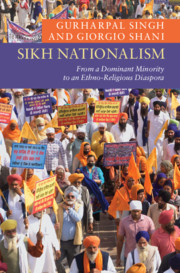Book contents
- Sikh Nationalism
- New Approaches to Asian History
- Sikh Nationalism
- Copyright page
- Contents
- Maps
- Figures
- Tables
- Acknowledgements
- Abbreviations
- Glossary
- Introduction
- 1 Understanding Sikh Nationalism
- 2 Sikhism and the Sikhs up to the 1890s
- 3 The Emergence of Modern Sikh Nationalism, 1880s–1930s
- 4 The Partition of India and the Sikhs, 1940–1947
- 5 The Indian Union and the Sikhs, 1947–1984
- 6 Militancy, Antiterrorism and the Khalistan Movement, 1984–1997
- 7 Sikh Nationalism in the Age of Globalisation and Hindutva, 1997 to the Present
- 8 The Diaspora
- Conclusion
- Timeline
- Appendix: Anandpur Sahib Resolution
- References
- Index
- New Approaches to Asian History
2 - Sikhism and the Sikhs up to the 1890s
Published online by Cambridge University Press: 19 November 2021
- Sikh Nationalism
- New Approaches to Asian History
- Sikh Nationalism
- Copyright page
- Contents
- Maps
- Figures
- Tables
- Acknowledgements
- Abbreviations
- Glossary
- Introduction
- 1 Understanding Sikh Nationalism
- 2 Sikhism and the Sikhs up to the 1890s
- 3 The Emergence of Modern Sikh Nationalism, 1880s–1930s
- 4 The Partition of India and the Sikhs, 1940–1947
- 5 The Indian Union and the Sikhs, 1947–1984
- 6 Militancy, Antiterrorism and the Khalistan Movement, 1984–1997
- 7 Sikh Nationalism in the Age of Globalisation and Hindutva, 1997 to the Present
- 8 The Diaspora
- Conclusion
- Timeline
- Appendix: Anandpur Sahib Resolution
- References
- Index
- New Approaches to Asian History
Summary
This chapter is divided into five sections. Firstly, it situates the origins of Sikhism within the historical traditions of northern India. This is followed by an examination of how the new tradition was gradually institutionalised to accommodate its growing appeal in the century after Nanak’s birth. It then assesses the turn to militancy from the end of the seventeenth century onwards, the creation of the Khalsa and the related question of political sovereignty. This is followed by an outline of how the turn to militancy triggered the process of state formation in the eighteenth century which climaxed in the creation of Ranjit Singh’s empire. Finally, the chapter reflects on the impact of the British Raj on the rise of modern Sikh identity with reference to the colonial discourses of Sikhs as a ‘nation’ and Sikhism as a ‘world religion’.
- Type
- Chapter
- Information
- Sikh Nationalism , pp. 31 - 51Publisher: Cambridge University PressPrint publication year: 2021

